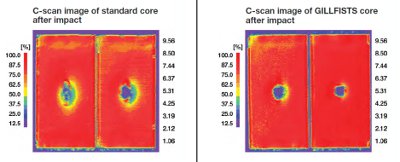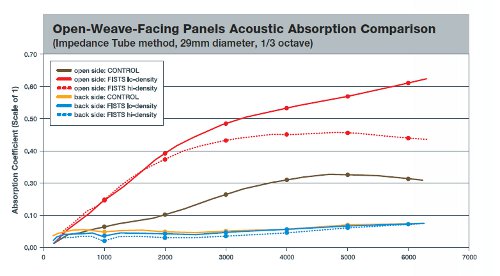Over the past 20 years, sandwich panels have increasingly come to serve as the backbone of flooring, wall, and partition manufacturing for aircraft design. Fabricated by sandwiching a relatively thick sheet of honeycomb core between two strong, thin facing sheets of metal or fiber-reinforced plastic, this construction delivers an excellent balance of strength, stiffness, and weight.
The literal and figurative “core” of this design is the honeycomb. Typically fabricated from aramid paper or aluminum foil, honeycomb core consists of closely packed arrays of hollow hexagonal or rectangular channels. It offers high mechanical strength, durability, and corrosion resistance with a remarkably lightweight footprint. Yet for designers working with more difficult requirements or harsher operating environments, this material may have some inadequacies. Compared to foam cores, while the honeycomb’s cellular structure affords superior stiffness and strength with much less weight, it also means that heat and noise vibration can travel more easily through the panel thickness. This does not make for ideal thermal insulation or acoustic management characteristics. In addition, the core’s hollow cells make it, and the facing sheets, more susceptible to damage by impacts.
These design characteristics can be overcome, but standard industry solutions are often accompanied by unwanted costs, weight increases, less-than-desired benefits, or trading one objection for another. However, a revolutionary new manufacturing process has made it possible to achieve improved thermal insulation, better acoustic properties, and superior damage tolerance in honeycomb while avoiding many of the traditional compromises.
The Process
This new honeycomb manufacturing process, known as GillFISTS® (Foamed In-situ Thermosetting System) is a new answer to an established industry practice: filling the honeycomb cells with a dampening foam. This has long been a technique for improving the acoustic and thermal insulation of sandwich panels, as it fills the air channels in the honeycomb’s hollow hexagons. However, previous methods have produced an array of problems: limiting the process to certain densities, generating a large amount of unwanted dust or debris, contaminating other materials in the sandwich layup process, or interfering with the bonding surface.
The GillFISTS method circumvents these issues by having the foam generate in-situ during the bonding process. The core is coated with a thermally activated foaming material, which only foams once the core is used to make a sandwich construction. After the honeycomb has been placed between two composite skins, heat and pressure are applied to cure the composite skins, just as in any sandwich panel assembly. Once the heat exceeds 125°C, the coating begins to foam and fills the cells of the honeycomb.
As a result, the end user does not have to handle foam, and the material can be processed like a regular piece of core. Density can be easily controlled by the coating formulation, which is available in a range from 0.3 to 1.5 lb per cu ft (pcf).
“The nice thing about GillFISTS honeycomb is that it can be machined like normal honeycomb,” explained Matt Lowry, director of research and development at M.C. Gill Corp. “The coated expandable material inside the FISTS honeycomb cells is only activated by heat after the skin-honeycomb-skin assembly has been put together, and so end users do not have to deal with any associated complications.
“In addition, the formulation is water-based, so there are no volatile organic components introduced into the atmosphere,” continued Lowry. “The process of manufacturing GillFISTS is simple, requiring no additional consumable materials or excess use of energy. This makes for a much more environmentally friendly manufacturing process than the alternatives.”
While the process itself represents a step forward in sandwich panel manufacturing, the resulting panels also exceed industry expectations. In a series of laboratory tests and analyses, GillFISTS panels were proven to provide improved thermal insulation, better acoustic properties, and superior damage tolerance as compared to standard core.
Damage Tolerance
Researchers compared two sandwich panel constructions, both based on 1/8 in. cell, 2.5 pcf paramid core. The first panel was fabricated using standard core, while the second panel contained core that had a FISTS coating applied at a density of 1.5 pcf. The panels were then impacted with a 1 in. (25.4 mm) spherical dart with an impact energy of 350 in.-lb.
When cross-sectional slices of the two sandwich panels were compared, both the depth and lateral extent of the damage were less in the GillFISTS panel. The standard core showed core fracture damage extending at least 6 cells away from the point of impact, while the GillFISTS material sustained damage only one cell away from the point of impact.

In addition, the research team utilized a C-scan ultrasonic inspection technique to assess any unseen internal damages resulting from the impact. Again, the standard core revealed much greater damage than the GillFISTS core.
“This remarkable improvement in damage tolerance was achieved with only 1.5 pcf increase in core density,” explained Lowry. “The GillFISTS core remained significantly stronger than the standard core, but not significantly heavier. This opens up new avenues for aircraft engineers to increase damage tolerance without employing bulkier, more involved methods. Instead of adding weight or incurring extra costs, engineers can use GillFISTS-enhanced core to increase damage tolerance.”
Thermal Insulation
As mentioned above, standard core allows heat to travel with relative ease through the panel thickness. Researchers therefore measured the thermal insulation properties of GillFISTS core to gauge any comparative improvements in its thermal conductivity.
“When we look at thermal insulation,” explained Lowry, “there are really two factors to consider. First, the material’s thermal conductivity, which is a measure of how much heat is transmitted through a standard thickness for every degree of temperature in a standard amount of time — essentially, a measurement of how easily heat can flow through a material. Second, we have to consider the thickness of material present. In general, the more material there is and the lower the thermal conductivity, the greater the insulation capacity will be.”
When the research team compared the thermal conductivity of GillFISTS with that of standard core, the thermal conductivity of the GillFISTS core measured 0.023 BTU/h*ft*°F, versus the standard core’s measurement of 0.031. In the panel tested, this difference between the GillFISTS core and the standard honeycomb was the equivalent insulative value of a brick wall 2.5 in. thick.
It was therefore not surprising that the GillFISTS core exceeded standard core in thermally insulated cabinet tests. Under external conditions of 29°C/70%RH, the internal temperature of the cabinet needed to be stabilized within 3 hours and maintained for up to 21 hours. While the GillFISTS core succeeded, the standard honeycomb fell well short.
“The thermal conductivity of materials is an important engineering property which factors into a lot of other design considerations,” said Lowry. “It can be especially influential in aircraft manufacturing, where maintaining a pleasant temperature for passengers and staff is essential. Since it is not hollow inside, unlike standard core, GillFISTS core does not allow for convective air currents inside each cell – this is what allows heat to pass through a standard honeycomb panel. Using GillFISTS should help to simplify or streamline commercial aerospace designs for thermal insulation.”
Acoustic Management

The management of sound inside an airplane is a complex science, entailing a variety of factors and calculations that cannot be fully examined in an article of this length. However, the GillFISTS panels showed significant improvements in transmission loss and acoustic absorption, two factors that affect sound management inside an aircraft.
“Transmission loss is an acoustic measurement which indicates how much sound intensity changes as the sound waves move away from their source,” said Lowry. “In general, the higher the transmission loss, the better, if one is trying to manage unwanted sounds inside an airplane flying at altitude.”
When tested against standard core, GillFISTS showed significant improvements (3 db) in transmission loss that are noticeable in the higher frequency range. This offers modest improvements in the range of frequencies most important to passenger air cabin comfort.
The GillFISTS core was also tested for acoustic absorption. Researchers found that the absorption of sound was significant when foam was present, making improved acoustic absorption a clear benefit of the GillFISTS material.
The standard panel showed some moderate absorption of sound, peaking at a coefficient of about 0.25. GillFISTS core treated with high density foam showed some absorption, but plateaued at about a frequency of 3,000 Hz. The low density foam filled panel, however, showed significantly improving absorption properties over the entire range of frequency.
“These acoustic benefits are very interesting,” said Lowry, “because they are achieved with very little additional weight to the sandwich construction. The GillFISTS panel not only offered higher transmission loss, but also superior sound absorption. This offers the potential to reduce weight in the aircraft by eliminating or reducing some of the other sound management strategies, such as adding weight, insulating, or completely changing the design of the aircraft. These all have associated costs that can be significant.”
Conclusions
Based on these laboratory tests, it can be concluded that the coated GillFISTS honeycomb core offers increased damage tolerance, improved acoustic properties, and better thermal insulation as compared to standard core.
“GillFISTS technology offers designers the possibility of integrating benefits such as damage tolerance, acoustic management, and thermal insulation directly into the part, either eliminating or greatly reducing the secondary processes and materials currently used,” explained Lowry. “Airframe manufacturers can therefore reduce overall costs or weight while improving their end product.
“This process is amenable to a wide range of chemistries and specific properties,” he continued. “Customers can work with M.C. Gill Corp.’s R&D staff to develop a specific solution for their needs, engineered to differentiate them from the competition. Whether they want a low-density, highly insulative core, or a high-density, damage-tolerant one, it can be manufactured just like a standard product — but with customized, above-standard results.”





